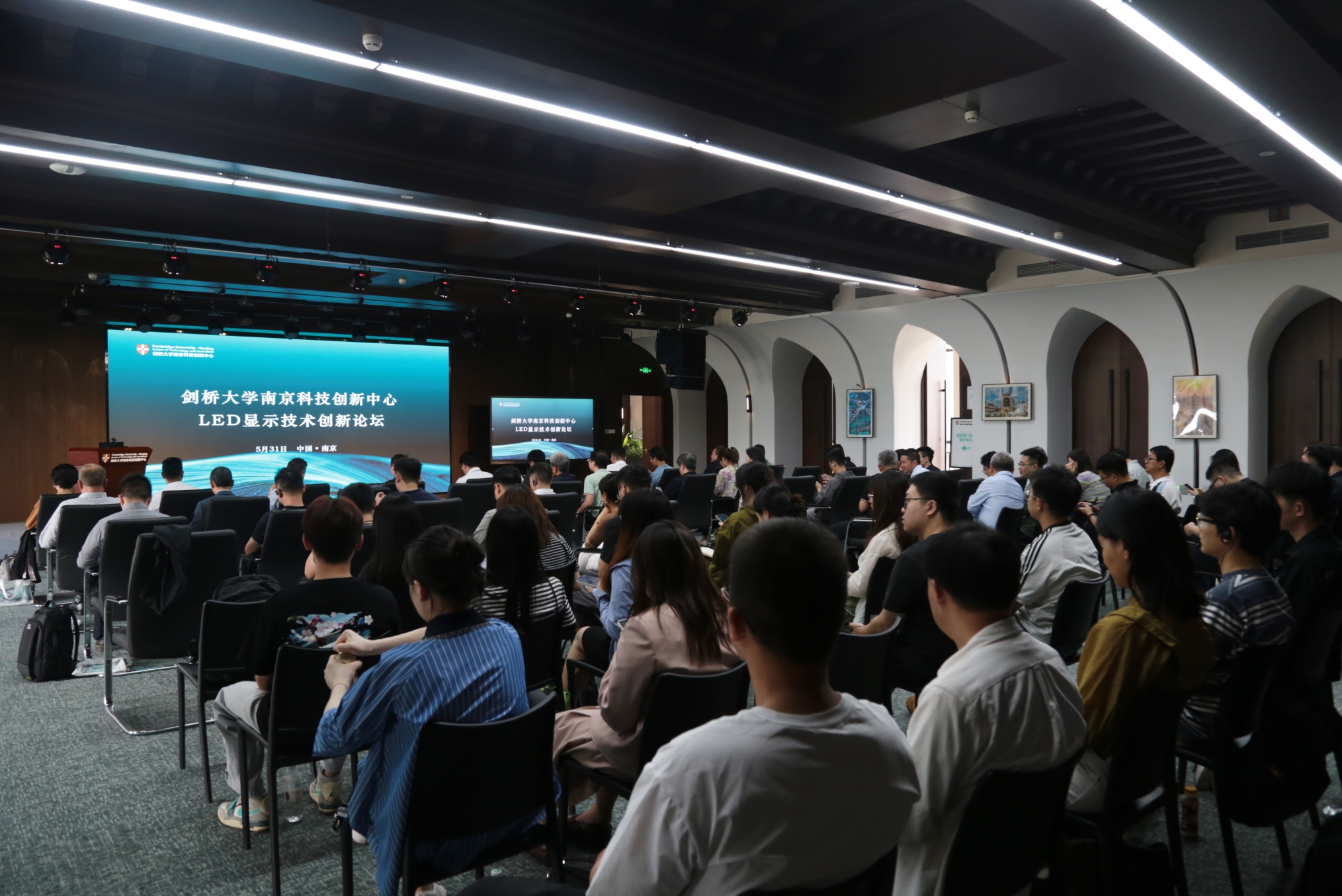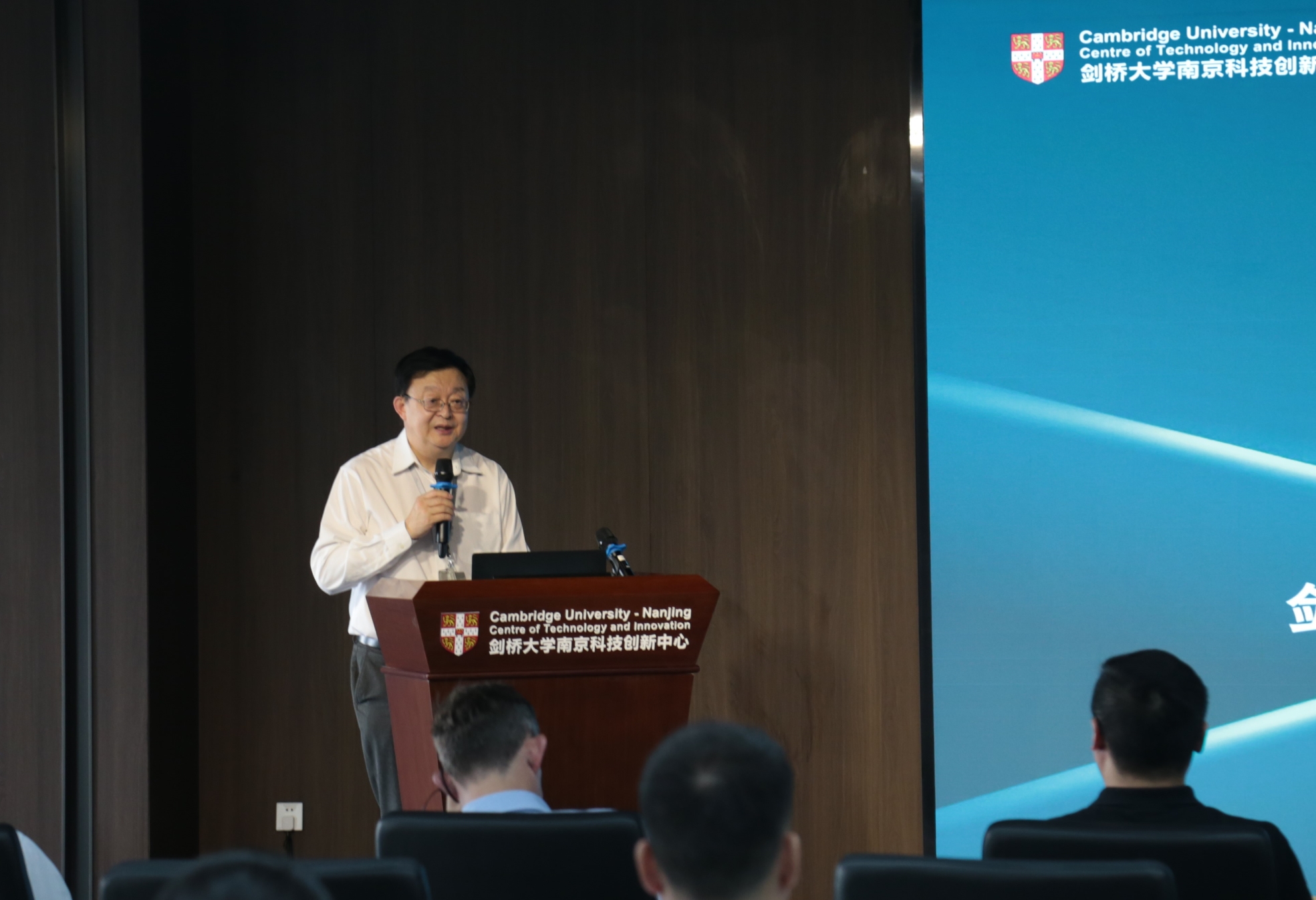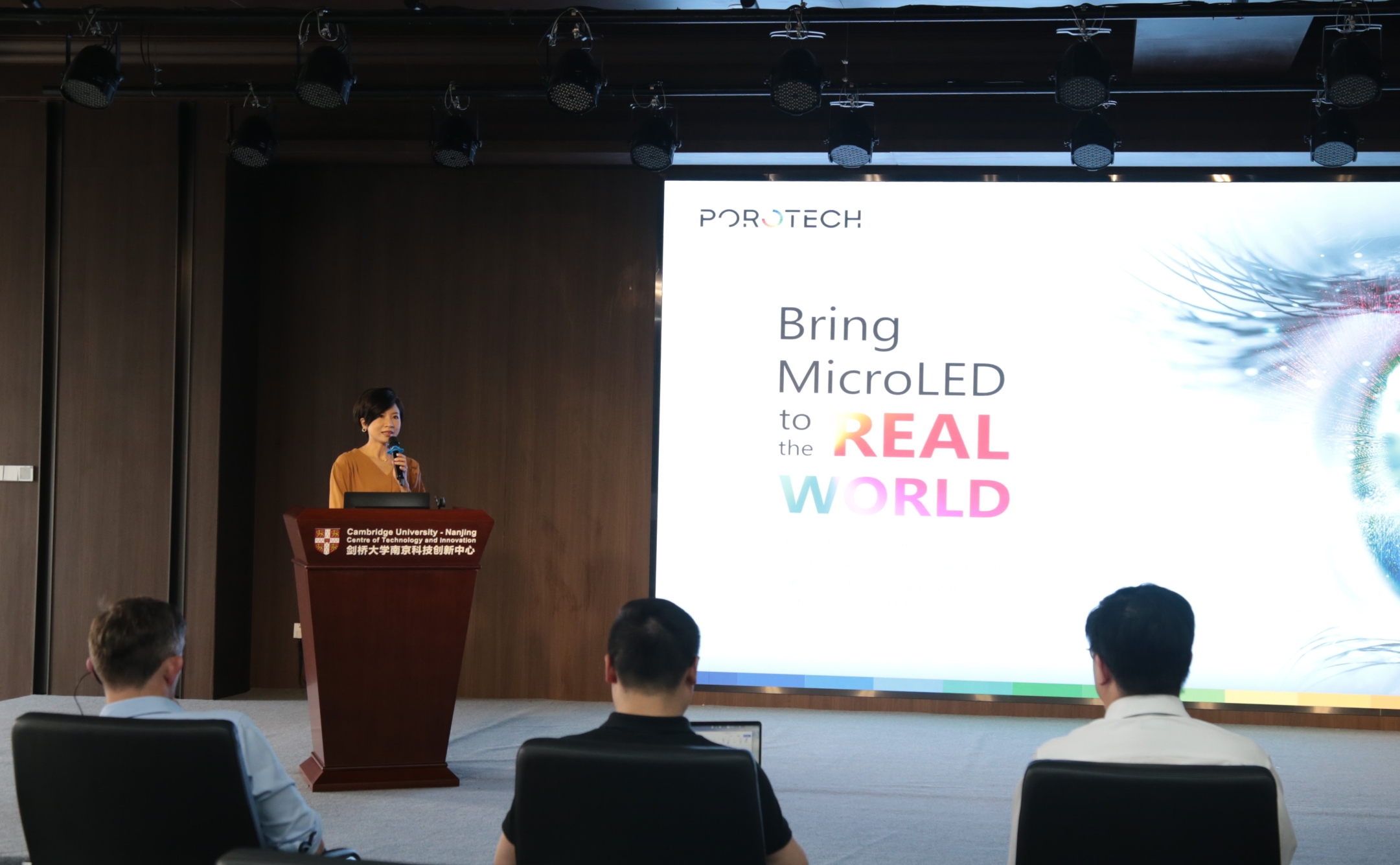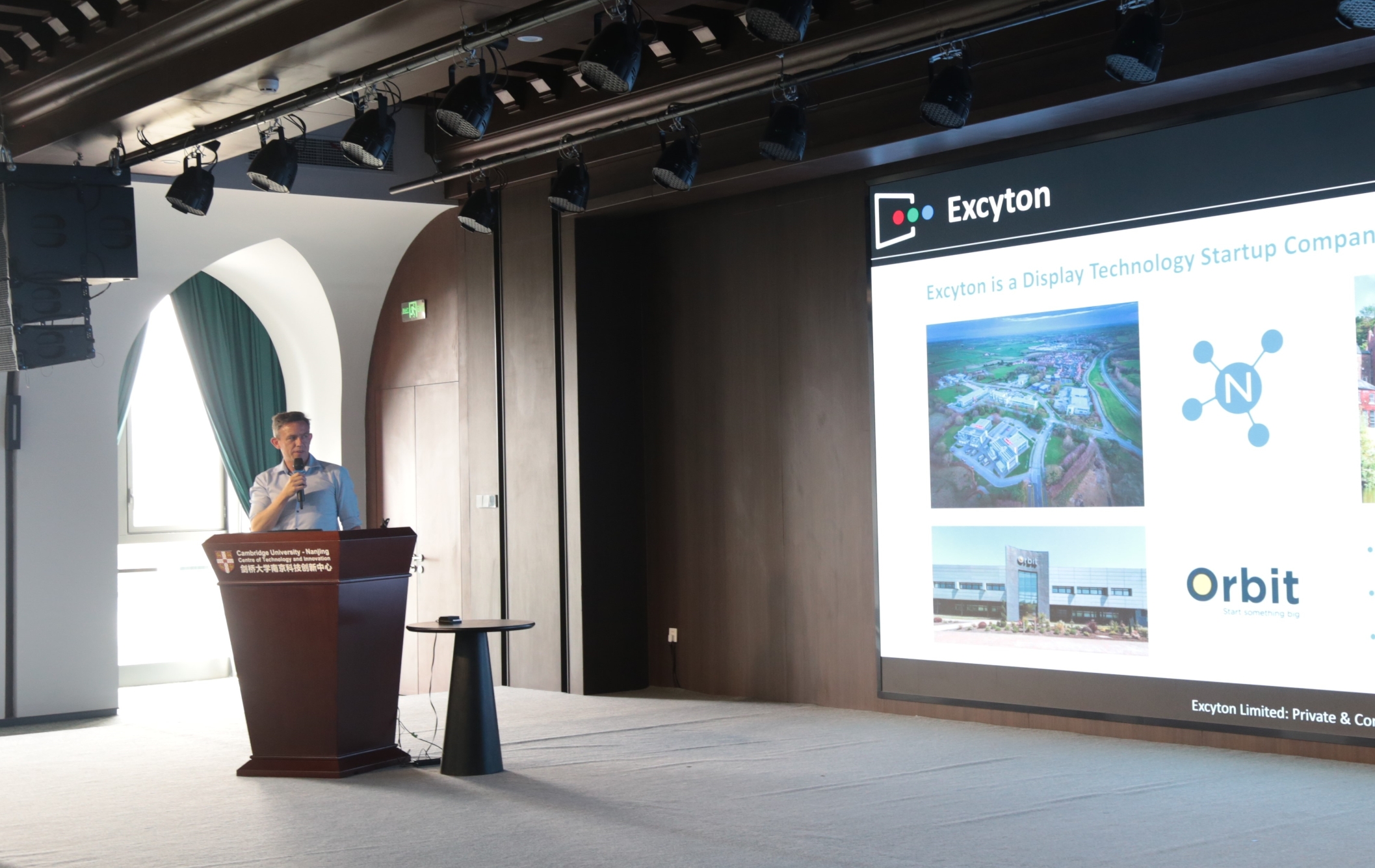CUNJC LED Display Technology Innovation Forum Held Successfully
On 31 May, Cambridge University - Nanjing Centre of Technology and Innovation (CUNJC) and Nanjing Overseas Collaborative Innovation Centre (Cambridge, UK) jointly held the "LED Display Technology Innovation Forum" successfully. The forum focused on the research and development of raw materials, breakthroughs in key technologies, exploration of application scenarios, and mass production in the LED display field, with nearly a hundred guests at home and abroad in the fields of the industry, research, and capital gathered by the Yangtze River to discuss trends of the industry and innovative pathways.
The forum scene
At the forum, multiple ground-breaking technology-based and application-oriented optical display companies, top domestic manufacturers in display industry, and representatives from well-known venture capital institutions such as Lanchi Ventures, Jiangsu GOVTOR Management, Gold-Tech Venture Capital, Xiaomi Strategic Investment, and KONKA Holdings Venture Capital were invited. Professor Daping Chu, tenured professor of the University of Cambridge, the Director of the Cambridge Centre for Photonic Devices and Sensors, and the Academic Director and CEO of CUNJC, along with Zhihui Zheng, Deputy General Manager-Project and Commercialisation , and Chris Pearson, Cambridge-Nanjing Centre Programme Manager attended the event.
New display technology represents the core foundation of electronic and information technology, a carrier and window for smart interactions and a typical industry for nurturing and developing new productive forces. Since 90% of human cognition stems from vision, currently the majority of users' demand for clearer, more immersive, more interactive, and more comfortable displays opens up broad prospects for the display industry.
"Good technology is the one 'applicable', and highly effective technology innovation empowers the industrial innovation," shared Professor Chu, "from '0' to '1' represents disruptive technological breakthroughs, and from '1' to '10' and from '10' to 'N' represent the massive release of value. Cultivating and developing new productive forces propels the critical leap from '0 to 1' in the 'laboratory' to '1 to N' in the 'production line', which is inseparable from extensive international collaboration and a deep integration of technological and industrial innovation."
Currently, as a supporting platform for the comprehensive development of Cambridge University in China, CUNJC prioritises technological innovation, targets on local dominant industry needs, adheres to the development concept in light of local conditions, and gathers global innovative resources including those from Cambridge University itself. It strives to eliminate stumbling blocks, bottlenecks, and difficulties in the R&D commercialisation chain, accelerate the application of technological innovation outcomes to the industrial chain and specific scenarios, and empowers the momentum of new productive forces.

Professor Chu's speech
The massive spread of information in the Internet age relies heavily on display devices as media. From desktop computers to laptops, mobile phones, and virtual reality devices, display devices have evolved from two-dimensional to three-dimensional forms. Innovative technological pathways are essential to overcoming technological bottlenecks, which are crucial for enhancing the competitiveness and commercialisation level of display technology. At the forum, two overseas companies, Porotech and Excyton, shared their key innovations and disruptive breakthroughs in display technology.
Founded in 2020, Cambridge University spin-off, Porotech, has developed the world's first red Micro-LED screen based on natural red indium gallium nitride (InGaN) by using its revolutionary multifunctional material platform, PoroGaN®, which breaks through the industry bottleneck that gallium nitride materials can only produce blue/green Micro-LEDs. And it produces the world's first monolithic full-colour Micro-LED display and projector based on DynamicPixelTuning®, a system that enables monochrome RGB integration, which saves two-thirds of the time and manufacturing process compared to traditional RGB three-color model. Currently, Porotech has successfully processed a 0.12-inch micro-display screen on 8-inch GaN-silicon semiconductor, with a sample size smaller than a fingernail, and mass production is forthcoming.

Protech's sharing
Generally, OLED displays consume 50% of power on tablets, laptops, and smartphones, but they only render 52% of visible colours, and the display lifetime of blue light is significantly shorter than that of red and green ones. The OLED display technology startup, Excyton, was founded in UK in 2019 and has developed a unique TurboLED® technology pathway. Unlike the RGB single pixel display (such as iPhone) or the stacked same-depth RGB display (like Apple iPad Pro) commonly found in OLED screens, this ground-breaking technology stacks light and deep RGB sub-pixels, potentially saving about 50% of power consumption, rendering 50% more colours, and extending the display lifetime by 3 times.

Excyton's sharing
Technologies should be renewable and application-oriented. It has been implemented in different application scenarios such as micro displays, AR wearable devices, and on-vehicle devices. At the event, Shenzhen Optiark, which combines Micro-LED and diffractive waveguide technologies, Beijing Summer Sprout, which optimises devices to reduce the capacitance of red OLEDs and improve OLED smearing problem, Nanjing ReaVis, which uses parallel vector and 3D AR-HUD technology to achieve shadow-free projection on standard windshields, Lark Optics, a Cambridge University spin-off that alleviates physical discomfort from wearing AR glasses through retinal projection technology, and the Xiamen Future Display Technology Research Institute, which focuses on Micro-LED research and development, all shared their research progress and industrialisation practices.
Regarding the prospect and cooperative opportunities of LED display technology, several major domestic display manufacturers went on keynote sharings at the event. With Professor Daping Chu as the host, there was an extensive discussion between technology explorers, application innovators, and veteran investors on how breakthrough inventions can be better put into mass production and commercialised and how cutting-edge technology can achieve a win-win cooperation between industry, research, and capital. In Professor Chu's view, the breakthrough of key technical issues and the widespread adoption of industrial products require multiple critical elements, including technologies, the market, industrial chains, and supply chains, with international and domestic collaboration playing an essential role. He hopes that CUNJC will serve as a pivot, on which university researchers will focus on addressing critical issues with prospects and effectively collaborate with the existing mature and rich industrial framework in China to help the domestic industry gain a competitive edge in the next-generation display technology landscape.
The industry pursues "new" and development aims for "quality"; we will march towards "light" together and fully "display" the future. Anchored on the demand of dominant industries, guided by application-oriented research, and aimed at the transfer and commercialisation of scientific research outcomes, CUNJC will continuously participate in the entire chain from scientific innovation to technology transfer and commercialisation, solidifying the hub function for international scientific cooperation to link Cambridge with China.
电话:+86 (0)25-56676020
邮箱:enquiry@cunjc.org.cn
地址:江苏省南京市江北新区荣悦路23号


中心B站账号


中心微信公众号
Copyright @ 剑桥大学南京科技创新中心有限公司 苏ICP备 19047554号-3
联系我们


中心B站账号

中心微信公众号
版权所有 ©剑桥大学南京科技创新中心
技术支持:三盛网络
 English
English 中文
中文